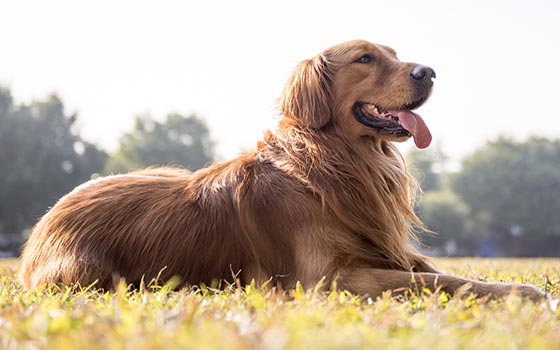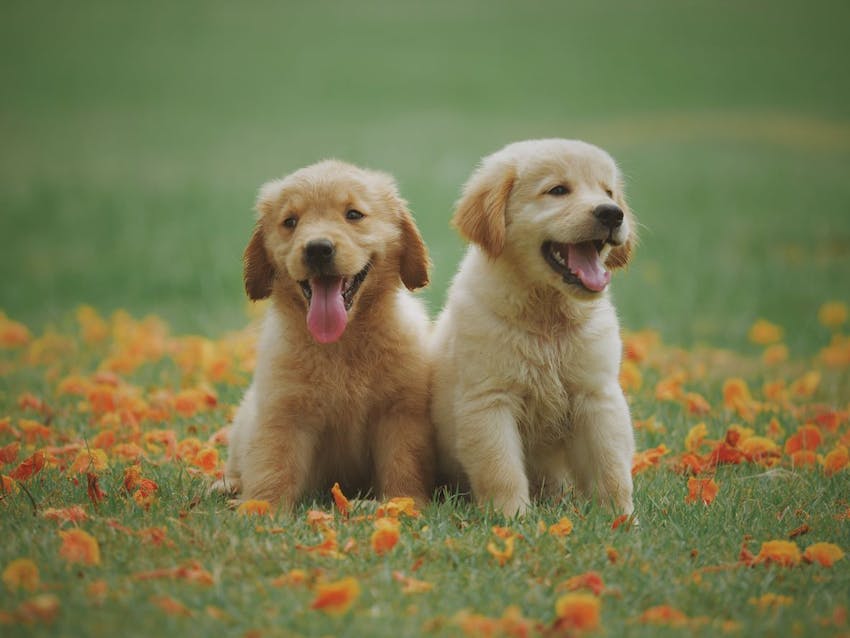Lifespan
10 to 12 years
By : Trupanion Staff | Updated Feb 14, 2024
Lifespan
10 to 12 years
Weight
Medium
Males: 65 - 75 pounds
Females: 55 - 65 pounds
Energy level
Tri-athlete
Breed Group
Sporting

While “Golden” is in the name, Golden Retrievers come in quite a range of colors, from a very light cream to more yellow and gold, and even dark red.
The Golden Retriever breed is often categorized into three different groups: American, Canadian, and British. These are all purebred Golden Retrievers, but have different physical characteristics based on the historical use of the breed geographically and the resulting bloodlines:
It's also worth mentioning that the Golden Retriever breed can get what’s called “Snow Nose.” This is where their dark nose loses its pigmentation and becomes a pink or brown color. While Snow Nose isn’t always a cause for concern, there are other reasons a dog’s nose might change color, such as contact dermatitis, an autoimmune disorder, or even an underlying thyroid condition. Check with your veterinarian if your Golden’s nose changes color.
When describing a Golden Retriever, the word “versatile” fits perfectly. Not only are they fantastic sporting dogs, but they excel in many other activities. Goldens are often used as service dogs for the blind or mobility-impaired and are ideal in search-and-rescue roles due to their toughness in the field and an excellent sense of smell. The Golden Retriever is loyal and eager to please, paired with a happy-go-lucky and playful personality. The one thing they aren’t particularly good at is guarding the home. They’re more likely to seek a pat on the head from an intruder than to chase them off.
The Golden Retriever is seen as a quintessential American breed due to its popularity in the United States, so it might come as a surprise that the Golden was actually developed in Scotland in the mid-1800s. Unhappy with the retrieving breeds available at the time and wanting a retriever able to work both on land and in water for waterfowl retrieving, Baron Tweedmouth began to develop the Golden Retriever by crossing water spaniels with retrievers.
He first crossed a retriever with the now extinct Tweed Water Spaniel breed, and later included the Irish Setter, St. John’s water dog (also extinct), the Bloodhound and other retrievers to eventually create what we now consider a purebred Golden Retriever.

Officially recognized by the Kennel Club in the United Kingdom in 1911, the American Kennel Club followed suit 14 years later in 1925. Since then, Golden Retrievers have consistently ranked as one of the most popular breeds in the United States based on AKC registrations.
Goldens are well-known for being one of the easier breeds to train, as they love both working with their humans and having a job to do (plus, they’ll do anything for food!). However, lifelong training is important for this breed as they are intelligent and need an outlet for their energy and desire to work. If you don’t give them appropriate activities, especially Golden puppies who like to put everything in their mouth, they’re likely to follow their nose and find something to do on their own, which might be more fun for them than it is for you.
While Goldens are known as a very social breed, proper proactive exposure to new sights, sounds, people, dogs, and other animals as a young puppy is essential for their socialization skills.
Pair meeting new people or animals with high-value training treats or a favorite toy, and keep introductions short and sweet, so it doesn’t get overwhelming.
Golden Retrievers are known to do well with children due to their outgoing personality and ability to cope with more physical handling. Make sure they have been properly introduced and socialized with children as a young puppy to set them up for success. Young children and dogs should always be supervised, and it’s helpful for a dog to have their own “safe space” where they can go when they need some quiet time.
Goldens can enjoy the companionship of other animals in the home, as long as they have been properly socialized and introduced. They’ve been known to take on the role of “mother” to abandoned puppies and other animals — a Golden named Lilly helped raise three Wild African dogs at the Oklahoma City Zoo.
Daily exercise is so important for this sporting breed. Golden Retrievers benefit from physical exercise beyond a daily walk around the block. They love to play fetch and swim (thanks to their webbed toes), which are great options to help them stay in shape. They also make excellent jogging or hiking partners, once they are fully grown, due to their medium size and endurance level.
Speak with your veterinarian about appropriate exercise for a Golden Retriever puppy. Until they are full-grown (bone growth plates typically all close by around 12 to 18 months of age), avoid strenuous or repetitive activities like jogging or running, as this can increase their risk of damage to the growing bone and cartilage, and cause pain and future joint issues.
While a tired dog might be a good dog, puppy exercise shouldn’t be forced or “pushed” in any way. Follow your puppy’s lead in the amount of activity they are able to do. If they stop and sit down, it’s time for some rest and recovery. In some cases, they might try to “keep up” with an adult dog, so make sure not to let them push too far and over-exercise themselves.
Mental enrichment is important for this fun and energetic breed! You can work their brains by teaching new tricks, attending obedience classes, joining a dog sport, and providing dog puzzles and interactive toys. These activities are a wonderful outlet for the seemingly endless puppy energy.
A Golden’s nose is an amazing thing! Working their sniffer uses a lot of brain power, making sniffing a powerful tool for mental enrichment. Provide your Golden with lots of sniffing opportunities on walks or hikes, or play a fun nosework game indoors on a rainy day.
Due to their love of companionship and social nature, Goldens need positive exposure to alone time from puppyhood, to prevent or minimize any separation anxiety issues as they get older. It’s much easier to prevent than to treat once it’s started. Make alone time a positive and relaxing experience for your Golden Retriever.
Any time you leave your Golden alone, pull out a frozen stuffed Kong or other yummy treat toy. When you return (even if only after thirty seconds), put it away until next time. This will help your Golden learn that when you’re gone, awesome stuff happens and they’ll make a positive association with your absence.
Golden Retrievers are known for using their mouths to pick up everything — those retrieving genes are strong! To prevent unwanted chewing and to keep them safe, spend lots of time teaching Leave It, Drop It, and providing appropriate toys to chew on or carry around.
Keep a basket of toys near your home’s entryway so you have easy access when your Golden is greeting visitors. By giving them something to hold in their mouth before your guests come in, you’ll help prevent any inappropriate mouthing and jumping on people.
Golden Retrievers enjoy a variety of dog sports and activities:
If you're like many people, there's a good chance you can recognize a Golden just by looking at them! Golden Retrievers are famous for their beautiful, flowy double-coat. This coat comes with a soft and dense undercoat to keep them warm, as well as a water-resistant long and flat topcoat.
Goldens should get a minimum of twice-weekly brushing, if not daily. Goldens are known to “blow coat” or shed excessively twice a year, usually in spring and fall, as their coat changes in preparation for hotter or colder weather. Brushing should be done frequently to prevent matting during these times. Intermittent professional grooming is usually needed for feather trimming and mat prevention. Introducing your Golden Retriever puppy to positive and calm grooming experiences from a young age will help them enjoy lifelong grooming.
Since Golden Retrievers love the water so much, it’s important to dry their coat and clean their ears after swimming fully. This will help prevent matting, hot spots, and other skin issues and minimize ear infections (which this breed tends to get).
Best Brush for Golden Retrievers: Pin comb, Slicker brush
Like all dog breeds, Golden Retrievers may be more susceptible to certain veterinary health conditions due to their genetics alone. For example, Goldens are known for being prone to hip and joint issues, such as hip dysplasia and elbow dysplasia. These conditions tend to be degenerative and are more common in older dogs (which is why you should sign up for a pet insurance plan that covers these conditions while your dog is still young).
According to the Golden Retriever Society, other common health issues seen in the breed include:
While seeing all these conditions listed out can be scary, it's important to keep in mind that even dogs in the same breed are individuals. It's important to talk to your dog's veterinarian about their unique health risks and any current conditions.

Kira (2019), a female English Golden Retriever, became a hero and instant global sensation, when on her own accord, she twice assisted her owner in breaking through the ice and rescuing two dogs stranded separately in a frozen lake, rounding up each animal and guiding them safely to shore. The video of the rescue vent viral and gained over 100 million views in just under one week.